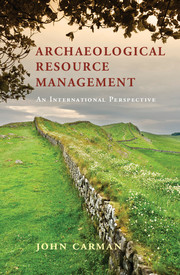4 - Inventory
from Part II - Practices
Published online by Cambridge University Press: 05 September 2015
Summary
Inventory and recording are rarely mentioned in the international comparative literature of ARM (see, e.g., chapters in McManamon and Hatton 2000; Layton et al. 2004; Messenger and Smith 2010), and, where mentioned, they are glossed over or combined with other activities such as survey (e.g., chapters in Cleere 1984a). They are also rarely given their proper status in reviews or discussions of national systems of ARM (see, e.g., Sebastian and Lipe 2009; Smith and Burke 2007; although for an exception see Fraser and Newman 2006), and there are occasional explicit international approaches to the topic (e.g., National Museum of Denmark 1992). However, even where inventory and recording are mentioned among other aspects of ARM, they are frequently given rather short shrift (see, e.g., Schofield et al. 2011, 83–4) and are therefore assumed to be unproblematic in nature. The most common location for an explicit discussion of inventory and recording is in the field of applying computer systems to archaeology (e.g., Lagerqvist and Rosvall 1991; Kerrel et al. 1991; Fitz 1991; Corazzol 1991; Stancic and Veljanovski 2001; and other proceedings of the Computer Applications in Archaeology conferences), which separates them from the field of ARM and locates them in other sub-fields of archaeology.
The process of recording the heritage is nevertheless a key function of archaeological agencies at every level of organisation. The justification behind inventory is that no decision about the future of the archaeological resource can be taken unless there is clear knowledge of what it comprises (Thornes and Bold 1998, 1). As emphasised in Chapter 3, it is one of the roles of laws in the field to determine what particular characteristics heritage objects and places must have. Accordingly, the task of inventory is to match objects and places with that list of usually legally approved characteristics. Table 4.1 sets out the difference between the archaeological record and resource in this respect: whereas the archaeological record (the object of research activity) is identified by survey, the resource (the object of management) is identified by a process of categorisation. This involves, in particular, the matching of objects and places with the particular and predetermined attributes they need to have in order for them to be classed as archaeological objects. Such inventories of ‘approved’ ARM objects exist at every level of organisation. The UNESCO World Heritage List promoted and managed by ICOMOS is an inventory of those sites and places considered by individual nation-states to be of particular importance (Askew 2010). Similarly, at the national level in every state of the world certain sites are marked as being of particular importance or significance (an issue to be addressed in Chapter 5). However, in order that sites and places can be separated out as special, there also needs to be a general background inventory of all those things and places which fall into the remit of ARM.
- Type
- Chapter
- Information
- Archaeological Resource ManagementAn International Perspective, pp. 79 - 104Publisher: Cambridge University PressPrint publication year: 2015

